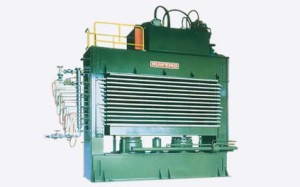Plywood Press Retrofit – Building A Smarter Steam Trap Solution
 SMART VALVES INC. was approached by a process engineer of Pacific Wood Laminates (PWL) with a serious problem he was having with an older model of a plywood press in their plant in Oregon. The press used an Armstrong #216 trap to collect the condensate from a platen press like the one shown in the photo. The trap was originally designed using a group trapping approach (one trap to capture the condensate from all the individual platens). The trap was failing even though it had been refitted with new internal parts several times in the past, yet continued to fail very quickly after being repaired. The customer was having to completely bypass the trap so that the press would operate. This in turn was causing problems with his condensate return system as well.
SMART VALVES INC. was approached by a process engineer of Pacific Wood Laminates (PWL) with a serious problem he was having with an older model of a plywood press in their plant in Oregon. The press used an Armstrong #216 trap to collect the condensate from a platen press like the one shown in the photo. The trap was originally designed using a group trapping approach (one trap to capture the condensate from all the individual platens). The trap was failing even though it had been refitted with new internal parts several times in the past, yet continued to fail very quickly after being repaired. The customer was having to completely bypass the trap so that the press would operate. This in turn was causing problems with his condensate return system as well.
Smart Valves Inc. recommended that the plywood press be retrofitted to have a small trap on each of the platens of the machine to eliminate the group trapping approach. The process engineer explained that his company had done this on a newer machine with similar problems, but did not want to spend a similar amount of capital on this older machine. They are expecting to replace this machine in the next 3 years.
After reviewing the pictures of the application and obtaining more technical information from the engineer about the process, the control valve and the steam supply, Smart Valves Inc. recommended replacing the Armstrong mechanical steam trap with a 2” SCi Venturi steam trap. We also recommended that a smaller ½” DSVTM steam trap be installed before the control valve to eliminate the possibility of condensate backing up when the control valve was closed Smart Valves Inc.ween press cycles.
Venturi steam traps have no moving parts to fail and depend on the pressure differential of the steam and condensate to regulate varying loads very effectively. The condensate load of the application was difficult to determine since the press was designed to handle several different thicknesses of plywood, each of which requires a different curing time on the press. Because of the various thicknesses and a huge variable load swing for the trap to handle from the beginning to the end of the press cycle, the ability to handle the variable load was a key factor in selecting the Venturi technology for the new trap.
The SCi and DSVTM Venturi traps were installed in October 2015 and after a few runs on the press, the engineer felt that there was still a great deal of steam getting through the SCi steam trap, indicating that we had misjudged the condensate load and the insert was too large for the application’s condensate load. After additional analysis by SMART VALVES INC., we decided a smaller insert would be required to eliminate the steam blowing through the trap. A new, smaller sized was supplied to PWL for their testing.
At this time, the SCi and DSV Venturi steam traps are both operating properly over a wide variety of plywood products being manufactured on this press and problems with steam loss through (or around) the trap and the over-pressurization of the condensate system have been completely eliminated.
Let’s discuss your needs

